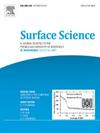Electronic and reactivity changes in epitaxially grown Ce1-xZrxO2-δ (111) thin films
IF 1.8
4区 化学
Q3 CHEMISTRY, PHYSICAL
引用次数: 0
Abstract
Ceria composite catalysts have long been used for ketonization reactions, which is a valuable chemistry for the upgrading of biomass-derived carboxylates. To better understand the interaction of zirconia with ceria in the context of ketonization, thin epitaxial films of ceria-zirconia mixed metal oxide Ce1-xZrxO2-δ (x = 0–1) were grown on a Pt(111) substrate in ultrahigh vacuum conditions and studied with X-ray photoelectron spectroscopy (XPS). Core level and valence band XPS results suggest a strong interaction between ceria and zirconia cations, possibly due to increased filling of unoccupied 4f0 orbitals of ceria from neighboring Zr cations in the lattice structure. This leads to a partial reduction of ceria from Ce4+ to Ce3+, with Zr remaining predominantly in the 4+ oxidation state. Ketonization of acetic acid was studied using temperature programmed desorption (TPD) and high-resolution electron energy loss spectroscopy (HREELS). These results found ketonization over mixed Ce-Zr composite oxides exhibited lower activation energies than for pure CeO2 and ZrO2, with Ce0.38Zr0.62O2-δ exhibiting the highest yield of acetone among the studied surfaces. These results suggest the high activity of Ce-Zr catalysts appears to be a result of oxygen vacancy formation, stabilized by electron donation from Zr cations.

外延生长Ce1-xZrxO2-δ(111)薄膜的电子和反应性变化
铈复合催化剂长期用于酮化反应,对生物质衍生羧酸酯的升级具有重要的化学意义。为了更好地了解氧化锆与氧化铈在酮化过程中的相互作用,在超高真空条件下,在Pt(111)衬底上生长了氧化锆-氧化锆混合金属氧化物Ce1-xZrxO2-δ (x = 0-1)薄膜,并用x射线光电子能谱(XPS)对其进行了研究。核能级和价带XPS结果表明,铈和氧化锆阳离子之间存在强烈的相互作用,这可能是由于晶格结构中相邻的Zr阳离子增加了未占据的440轨道。这导致铈从Ce4+部分还原为Ce3+, Zr主要保持在4+氧化态。采用程序升温解吸(TPD)和高分辨率电子能量损失能谱(HREELS)研究了醋酸的酮化反应。结果表明,混合Ce-Zr复合氧化物的酮化反应活化能低于纯CeO2和ZrO2,其中Ce0.38Zr0.62O2-δ丙酮产率最高。这些结果表明,Ce-Zr催化剂的高活性似乎是由于氧空位的形成,由Zr阳离子的电子捐赠稳定。
本文章由计算机程序翻译,如有差异,请以英文原文为准。
求助全文
约1分钟内获得全文
求助全文
来源期刊

Surface Science
化学-物理:凝聚态物理
CiteScore
3.30
自引率
5.30%
发文量
137
审稿时长
25 days
期刊介绍:
Surface Science is devoted to elucidating the fundamental aspects of chemistry and physics occurring at a wide range of surfaces and interfaces and to disseminating this knowledge fast. The journal welcomes a broad spectrum of topics, including but not limited to:
• model systems (e.g. in Ultra High Vacuum) under well-controlled reactive conditions
• nanoscale science and engineering, including manipulation of matter at the atomic/molecular scale and assembly phenomena
• reactivity of surfaces as related to various applied areas including heterogeneous catalysis, chemistry at electrified interfaces, and semiconductors functionalization
• phenomena at interfaces relevant to energy storage and conversion, and fuels production and utilization
• surface reactivity for environmental protection and pollution remediation
• interactions at surfaces of soft matter, including polymers and biomaterials.
Both experimental and theoretical work, including modeling, is within the scope of the journal. Work published in Surface Science reaches a wide readership, from chemistry and physics to biology and materials science and engineering, providing an excellent forum for cross-fertilization of ideas and broad dissemination of scientific discoveries.
 求助内容:
求助内容: 应助结果提醒方式:
应助结果提醒方式:


